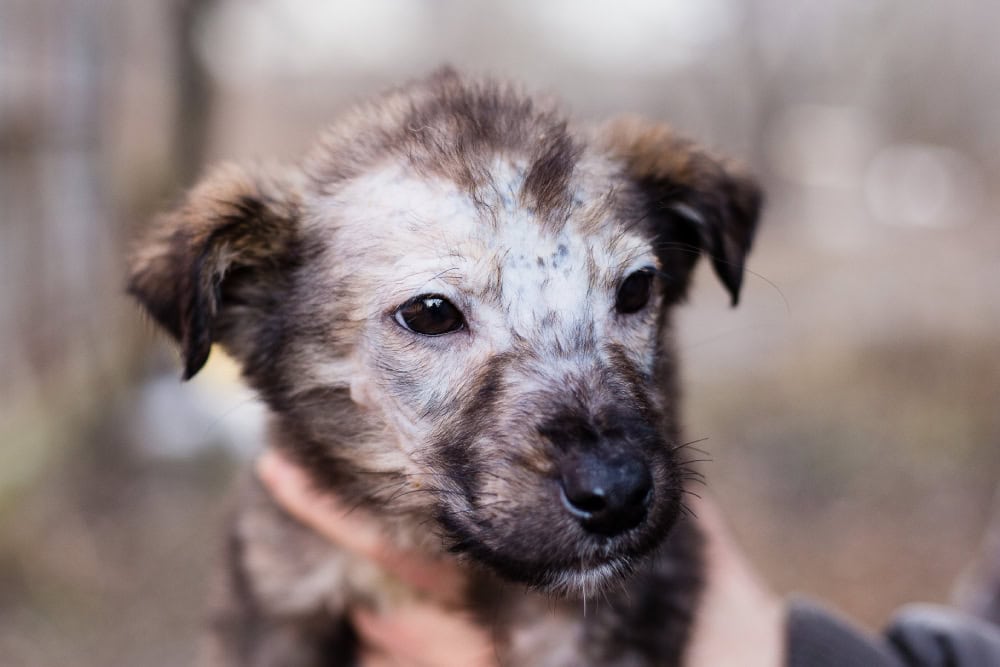
The information is current and up-to-date in accordance with the latest veterinarian research.
Learn more »
You recently adopted a puppy, and now you notice they have spots of hair loss. You’ve already scheduled a visit with your veterinarian to get caught up on vaccines. Let’s look at some things that could cause your puppy to have bald spots and what your vet will do about it.
Main Causes of Bald Spots in Puppies
There are lots of things that can cause alopecia, or hair loss, in puppies.Take into consideration some of the following questions:
Is your puppy itchy or pruritic?
Have you changed foods or treats recently?
What are you feeding your puppy?
Watch your puppy playing. Are they getting scratches from playing in the bushes, or do they regularly get into wrestling matches with their siblings?
Also, consider the surfaces that your dog enjoys lying on. Do you have a large dog that always picks the hardwood floor instead of their dog bed? That could contribute to callus formation along joints that touch the firmer surface.
1. Parasites
Fleas
External parasites like fleas are prevalent in dogs and can cause various health issues, including itching and hair loss. You can often see fleas on your pet, especially if you use an aptly named flea comb to comb through their hairs. In fact, flea allergy dermatitis is one of the most common skin conditions affecting dogs, with a 12.5% rise in cases noted in 2018.
Mites
Sometimes, hair loss is triggered by microscopic mites.
Sarcoptes is a very contagious mite, and it typically causes intense itching.
Demodex is a common skin mite that causes hair loss but doesn’t always cause itching. Common places to find these bald spots include the paws and muzzle.
The good news is that the widespread use of certain preventative products for oral fleas and ticks, such as Simparica Trio, has helped reduce the occurrence of mites. Off-label, these products treat mites.
Lice
Lice are usually species-specific, and several species affect dogs. They can cause itching and hair loss. You might see them—small, flightless, dark insects—crawling through your dog’s coat.
2. Genetics
Genetics can definitely explain your puppy’s bald spots. Some breeds more commonly develop pattern baldness, including the Chihuahua and Italian greyhounds. These dogs are not generally itchy.
Color Dilution Alopecia
Certain breeds have coat colors associated with alopecia, most notably blue or light fawn coat colors. Dachshunds are one such breed. Initially, these puppies have a normal coat, but gradually, the hair gets dry, dull, and thin.
Image Credit: FeSeven, Shutterstock
3. Skin Infections
Unfortunately, puppies tend to have an incompetent immune system that has to develop further to fight off many different bacterial and fungal Infections.
Ringworm or dermatophytes are common fungal infections. Dogs often develop hair loss and crusting lesions. Malassezzia is yeast and is regularly involved in skin infections.
Bacterial skin infections take many different forms:
Pruritus (itchiness)
Hair loss
Pustules
Epidermal collarettes
Crusts
4. Allergies
Allergies can impact dogs of any age. You might see food allergies or environmental allergies—or even a combination of the two.
Allergies manifest in many different ways:
Itching
Hair loss
Licking paws
Rubbing ears
Ear infections
Redness between toes
Skin infections
Some areas have differing pollen levels, sometimes contributing to allergy flare-ups.
Image Credit: Todorean-Gabriel, Shutterstock
5. Roughhousing or Trauma
A simple reason for bald spots in puppies? Trauma. It can be as simple as two puppies wrestling on the ground and pulling out hairs. Has your puppy been interacting with other animals?
6. Nutritional Deficiencies
You should feed your puppy a well-balanced food formulated to meet their nutritional needs. Check the food bag: Does it have an AAFCO statement outlining that it is complete, so you don’t worry about feeding it?
An appropriate diet makes your dog less likely to have a nutrient deficiency.
Some possible deficiencies inside:
Vitamin A: Deficiencies cause bald spots, flaky, dry skin, and relatively poor hair growth.
Vitamin E: Deficiencies in this antioxidant contribute to a weakened immune system.
Zinc: A lack of zinc, such as wish zinc-responsive dermatitis, can cause a brittle hair coat and even crusty skin lesions.
Skin support diets often include ingredients like fish oils. Omega-3 fatty acids can be quite beneficial when dealing with skin allergies.
Image Credit: Switlana Sonyashna, Shutterstock
7. Other Considerations
Climate can be a factor for your dog’s skin. Humid environments can make it more likely that your dog’s hair mats down.
Regular grooming can help prevent mats from forming. Something as simple as wiping your dog’s legs with a clean cloth can reduce allergens on your dog’s coat.
Diagnosing and Treating the Cause of Bald Spots in Dogs
Your veterinarian will usually start by performing a thorough physical examination. Sometimes, that’s all you need to get an answer. If there’s no apparent cause, your veterinarian might use one or more of the following tests.
Skin scrape is effective for looking for mites
Skin impression (cytology) is used to see if bacteria or fungal organisms are present on the skin, often used around nasal or tail folds and around nails
Fungal cultures
Blood work
Skin biopsy
The specific treatment will depend on what your vet finds. Flea prevention is essential, but a well-balanced diet is also critical for your pup’s overall health.
If there is evidence of an infection, your veterinarian might suggest antibiotics or antifungal medication. Veterinarians often utilize topical therapy, such as medicated shampoos and mousse. One company makes the highly effective Douxo Calm and Douxo Pyo. These topical treatments reduce the need for antibiotics, helping lower the risk of issues like antibiotic resistance and gastrointestinal side effects.
Image Credit: Ali _Cobanoglu, Shutterstock
Conclusion
If you notice bald spots on your puppy that can be explained by roughhousing with your other dogs, you should contact your veterinarian for an appointment. They may need to perform tests to find the underlying cause, but they’ll also formulate a plan to treat your dog’s hair loss.
Featured Image Credit: Elfangor, Shutterstock






